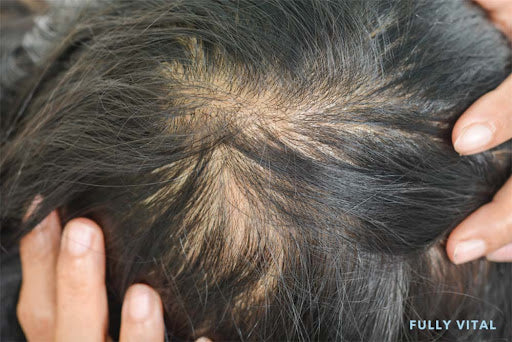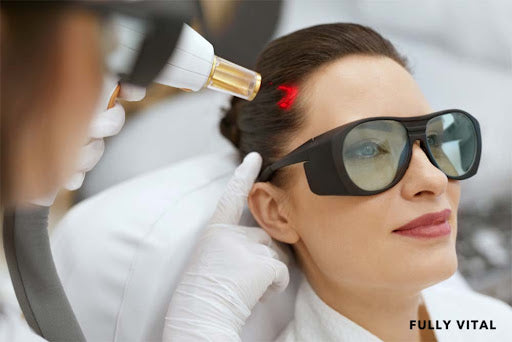
Trichorhinophalangeal Syndrome: Understanding And Preventing Hair Growth Issues
Trichorhinophalangeal syndrome, also known as TRPS, is a rare genetic disorder that impacts hair growth.
In this article, we will go into details of this syndrome, emphasizing its significance in understanding how it affects hair development.
We will also explore the advantages of raising awareness about TRPS and preventing its occurrence.
Additionally, we will examine potential downsides of its treatment and consider alternative approaches.
So, let's get started!

I LOVE MY HAIR NOW
FullyVital hair serum and hair vitamins made tremendous improvements in my hair. I truly love my hair now.
Dorit S.,
What Is Trichorhinophalangeal Syndrome?
Trichorhinophalangeal syndrome is a genetic condition characterized by abnormalities in hair growth, facial features, and skeletal development.
It is a rare disorder, primarily affecting women with different hair types.
Individuals with TRPS usually have thin, sparse hair, receded hairlines, and abnormal facial features such as a bulbous nose and thin upper lip.
Furthermore, skeletal abnormalities like short stature and abnormalities in the fingers and toes may also be present.1

Why Is Awareness Of Trichorhinophalangeal Syndrome Important?
Raising awareness about Trichorhinophalangeal syndrome is crucial for several reasons:
Empowering Individuals
Increased awareness empowers individuals affected by Trichorhinophalangeal syndrome (TRPS) by providing them with information about their condition.
Understanding the syndrome's characteristics, symptoms, and potential complications enables those with TRPS to make informed decisions regarding their healthcare and daily life.2
Early Identification and Intervention
Awareness campaigns play a vital role in identifying new cases of TRPS.
Early diagnosis is essential for timely intervention and support.
When healthcare professionals and the general public are more knowledgeable about TRPS, they are more likely to recognize its signs and symptoms, leading to earlier medical evaluations and interventions.
Support and Community Building
Building awareness fosters a sense of community among individuals and families affected by TRPS.
By connecting with others facing similar challenges, individuals can find emotional support, share experiences, and access valuable resources.
Awareness initiatives can help create dedicated support networks for TRPS patients and their families.
Advancing Research and Funding
Increased awareness of TRPS can attract attention from researchers, clinicians, and funding organizations.
As awareness grows, so does the interest in studying and understanding the syndrome.
This heightened interest can lead to more research projects aimed at discovering the underlying causes of TRPS, potential treatments, and ways to improve the quality of life for those affected.
Advocacy and Policy Changes
Awareness efforts often lead to advocacy initiatives aimed at improving the lives of individuals with TRPS.
These initiatives may include advocating for policy changes, increased healthcare access, and improved insurance coverage for TRPS-related treatments and therapies.
Enhancing Treatment Options
Ultimately, heightened awareness contributes to the development of better treatment options for TRPS.
Increased funding, research, and collaboration among experts can lead to breakthroughs in managing and potentially curing the syndrome.
This offers hope to individuals with TRPS and their families for a brighter future.
How Does Trichorhinophalangeal Syndrome Work?
Trichorhinophalangeal syndrome is caused by mutations in certain genes.
These mutations affect the development and functioning of hair follicles, leading to hair growth issues.
The abnormalities in facial features and skeletal development are a result of the same genetic mutations.
It's important to note that TRPS is an inherited condition, meaning it can be passed down from parents to their children.3
What Are The Benefits Of Preventing Trichorhinophalangeal Syndrome?
Here are some of the benefits of preventing trichorhinophalangeal syndrome:
Enhanced Appearance
Preventing or managing TRPS-related hair growth issues can significantly enhance an individual's overall appearance.
This improvement can boost self-esteem and contribute to improved mental and emotional well-being.4
Improved Quality of Life
Early intervention and appropriate treatment not only address hair growth issues but also help mitigate other symptoms associated with TRPS, such as skeletal abnormalities.
This comprehensive approach can lead to a better quality of life for those affected by the syndrome.
Increased Confidence
With effective management, individuals with TRPS may experience increased confidence and a greater sense of self-assurance.
This can positively impact their social interactions and overall life satisfaction.
Functional Benefits
Managing TRPS symptoms can improve an individual's physical function and mobility.
This is particularly important for addressing skeletal abnormalities and related challenges, allowing for a more active and fulfilling life.
Long-Term Health
Preventing or managing TRPS can also contribute to long-term health and well-being.
It can reduce the risk of complications associated with the syndrome and promote overall health and longevity.
What Are The Causes Of Trichorhinophalangeal Syndrome?
Trichorhinophalangeal syndrome is primarily caused by genetic mutations.
These mutations occur in the TRPS1 gene, which is responsible for encoding a protein involved in hair growth, facial development, and skeletal formation.
The exact cause of these mutations is not yet fully understood.
However, it is known that TRPS is an inherited condition that can be passed on from parent to child.5
What Are The Symptoms Of Trichorhinophalangeal Syndrome?
Trichorhinophalangeal syndrome presents with various symptoms that can affect individuals differently.
The following are some common symptoms associated with TRPS:
- Hair-related Symptoms:
- Thin and sparse hair
- Slow hair growth
- Receding hairline
- Unusual texture or structure of hair
- Facial Features:
- Bulbous nose
- Thin upper lip
- Prominent cheeks
- Skeletal Abnormalities:
- Short stature
- Abnormalities in the fingers and toes, such as shortened or tapered digits
- Joint stiffness
What Is The Role Of Genetics In Trichorhinophalangeal Syndrome?
Trichorhinophalangeal Syndrome (TRPS) is a rare genetic disorder with a complex genetic basis, and understanding these genetic aspects is pivotal in comprehending this condition.
Inheritance Pattern
- Trichorhinophalangeal syndrome is inherited in an autosomal dominant pattern. This means that an affected individual has a 50% chance of passing the condition to each of their children.6
- In some cases, TRPS may occur spontaneously due to new genetic mutations, without a family history of the syndrome.
Gene Mutation in TRPS1
- Mutations in the TRPS1 gene disrupt the normal functioning of the protein it encodes. This leads to the characteristic symptoms of TRPS, including hair growth issues, facial abnormalities, and skeletal changes.
What Are Tests And Diagnosis For Trichorhinophalangeal Syndrome?
Diagnosing Trichorhinophalangeal syndrome involves a combination of clinical evaluation, genetic testing, and imaging studies.
Here are the common diagnostic approaches:
Clinical Evaluation
- Physical examination to assess hair growth, facial features, and skeletal abnormalities.
- Evaluation of family medical history to identify any patterns suggestive of TRPS.
Genetic Testing
- Genetic tests, such as DNA sequencing, are conducted to identify mutations in the TRPS1 gene.
- Confirming the presence of a specific mutation can aid in confirming the diagnosis of TRPS.
Imaging Studies
- X-rays or other imaging techniques may be used to assess skeletal abnormalities associated with TRPS.
Unlock Your Hair's Potential With Fully Vital!Ready for a Rejuvenating Change? Imagine confidently flaunting your luscious locks every day. Say goodbye to sluggish growth, weak strands, and frustrating bad hair days with our hair growth products.
Gracefully age with Fully Vital! Turn back the clock on aging hair and embrace the full, luscious head of hair that's been waiting for you. Try Fully Vital Today! |
Final Thoughts On Trichorhinophalangeal Syndrome
Trichorhinophalangeal syndrome is a rare genetic condition that significantly impacts hair growth, facial features, and skeletal development.
By increasing awareness, understanding its mechanisms, and exploring preventive measures, we empower individuals affected by TRPS to take charge of their hair growth journey.
Through early intervention and appropriate treatment, we can mitigate the effects of TRPS and improve the quality of life for those living with this syndrome.
At Fully Vital, we understand the unique challenges faced by individuals with TRPS and their desire for a healthy relationship with their hair.
While we don't have specific products tailored to TRPS, our wide variety of hair growth products can help support overall hair health and vitality.
We encourage you to explore our offerings to find the right solutions for your hair care needs.
Remember, you don't have to face Trichorhinophalangeal syndrome alone. Together, let's strive for improved management and support, so that everyone can embrace the beauty of their unique locks.
Frequently Asked Questions On Trichorhinophalangeal Syndrome
Are There Lifestyle Changes That Can Help Manage TRPS?
While lifestyle changes cannot cure Trichorhinophalangeal syndrome, they can contribute to better management of its symptoms.
Consider the following lifestyle adjustments:
- Healthy Hair Practices: Maintaining good hair care habits, such as gentle washing, avoiding excessive heat styling, and using products suitable for your hair type.
- Regular Exercise: Engaging in daily physical activity to promote overall well-being, including maintaining healthy bones and joints.
- Proper Nutrition: Following a balanced diet rich in essential nutrients, such as vitamins, minerals, and proteins, which are vital for healthy hair growth and overall health.
What is Trichorhinophalangeal Syndrome Type 3?
Trichorhinophalangeal syndrome type 3 (TRPS3) is a sub-type of TRPS, characterized by distinct symptoms and variations.
It is caused by mutations in a different gene called the TRPS1 enhancer.
This type of TRPS may present with similar hair growth issues, facial abnormalities, and skeletal variations as other sub-types, but with potential differences in severity and specific features.
How to Manage Pain Associated with TRPS?
Individuals with Trichorhinophalangeal syndrome may experience pain, particularly due to skeletal abnormalities and joint stiffness.
Here are some pain management strategies:
- Medication: Over-the-counter pain relievers or prescribed medications recommended by healthcare professionals.
- Physical Therapy: Engaging in exercises to improve flexibility, strengthen muscles, and potentially alleviate pain.
- Heat or Cold Therapy: Applying heat packs or cold compresses to affected areas can help reduce pain and inflammation.
Is TRPS Contagious?
No, Trichorhinophalangeal syndrome is not contagious.
TRPS is a genetic condition inherited from parents, and it is not transmitted through physical contact or exposure to affected individuals.
Is TRPS Progressive?
Trichorhinophalangeal syndrome is generally not considered a progressive condition.
The symptoms associated with TRPS typically remain stable throughout an individual's life.
However, the specific features and severity of symptoms may vary among affected individuals.
Is TRPS Genetic?
Yes, Trichorhinophalangeal syndrome is a genetic condition caused by mutations in the TRPS1 gene (for most sub-types) or the TRPS1 enhancer gene (for TRPS3).
These gene mutations are responsible for the development and manifestation of TRPS.
What Specialist Should I See for TRPS?
When seeking medical care for Trichorhinophalangeal syndrome, it is recommended to consult with various healthcare professionals, including:
- Dermatologist: Specializes in the diagnosis and management of skin-related issues, including hair growth abnormalities.
- Orthopedic Surgeon: Specializes in treating skeletal abnormalities and joint problems.
- Genetic Counselor: Provides guidance and information regarding the genetic aspects of TRPS, inheritance patterns, and family planning.
Can People with TRPS Have Children?
Yes, individuals with Trichorhinophalangeal syndrome can have children.
However, given the genetic nature of TRPS, it is advisable for affected individuals to consult with a genetic counselor before planning a family.
They can provide detailed information about the risks of passing on the condition and options available for reproductive planning.
Who is at Risk for TRPS?
Trichorhinophalangeal syndrome can affect individuals of any gender or ethnicity, although it tends to primarily affect women.
As TRPS is an inherited condition, individuals with a family history of TRPS or known gene mutations associated with TRPS are at a higher risk of developing the syndrome.
Can TRPS be Prevented?
As Trichorhinophalangeal syndrome is caused by genetic mutations, it may not be entirely preventable.
However, with increased awareness and genetic counseling, individuals at risk of passing on TRPS to their children can make informed decisions about family planning options and potential prenatal screening.
Early diagnosis and treatment can also help manage symptoms and minimize their impact on daily life.
Sources:
- Trippella, G., Lionetti, P., Naldini, S., Peluso, F., Monica, M. D., & Stagi, S. (2018). An early diagnosis of trichorhinophalangeal syndrome type 1: a case report and a review of literature. Italian Journal of Pediatrics, 44(1). https://doi.org/10.1186/s13052-018-0580-z
- Maas, S., Shaw, A., Bikker, H., & Hennekam, R. C. (1993). Trichorhinophalangeal Syndrome (M. P. Adam, H. H. Ardinger, R. A. Pagon, S. E. Wallace, L. J. Bean, G. Mirzaa, & A. Amemiya, Eds.). PubMed; University of Washington, Seattle. https://www.ncbi.nlm.nih.gov/books/NBK425926/
- Ahmed, A., Almohanna, H., Griggs, J., & Tosti, A. (2019). Genetic Hair Disorders: A Review. Dermatology and Therapy, 9(3), 421–448. https://doi.org/10.1007/s13555-019-0313-2
- Dhami, L. (2021). Psychology of Hair Loss Patients and Importance of Counseling. Indian Journal of Plastic Surgery : Official Publication of the Association of Plastic Surgeons of India, 54(4), 411–415. https://doi.org/10.1055/s-0041-1741037
- Chen, L.-H. ., Ning, C.-C. ., & Chao, S.-C. . (2010). Mutations in TRPS1 gene in trichorhinophalangeal syndrome type I in Asian patients. The British Journal of Dermatology, 163(2), 416–419. https://doi.org/10.1111/j.1365-2133.2010.09802.x
- Trichorhinophalangeal syndrome type I: MedlinePlus Genetics. (n.d.). Medlineplus.gov. Retrieved October 6, 2023, from https://medlineplus.gov/genetics/condition/trichorhinophalangeal-syndrome-type-i/







